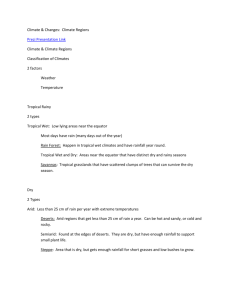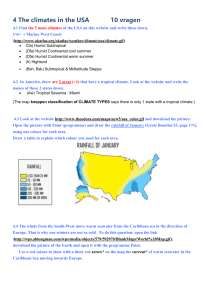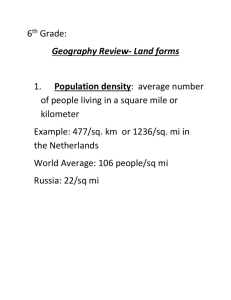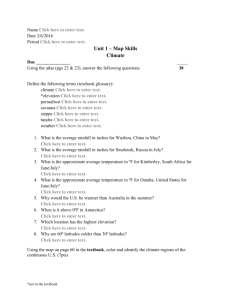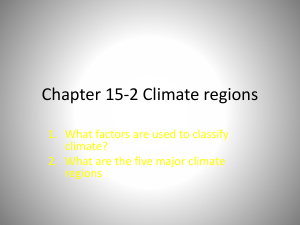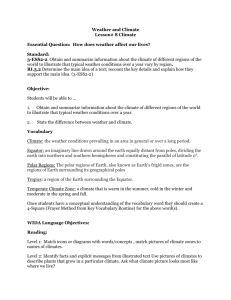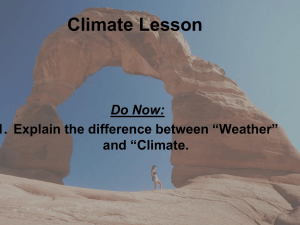Sections 2 and 3 - Revere Local Schools
advertisement
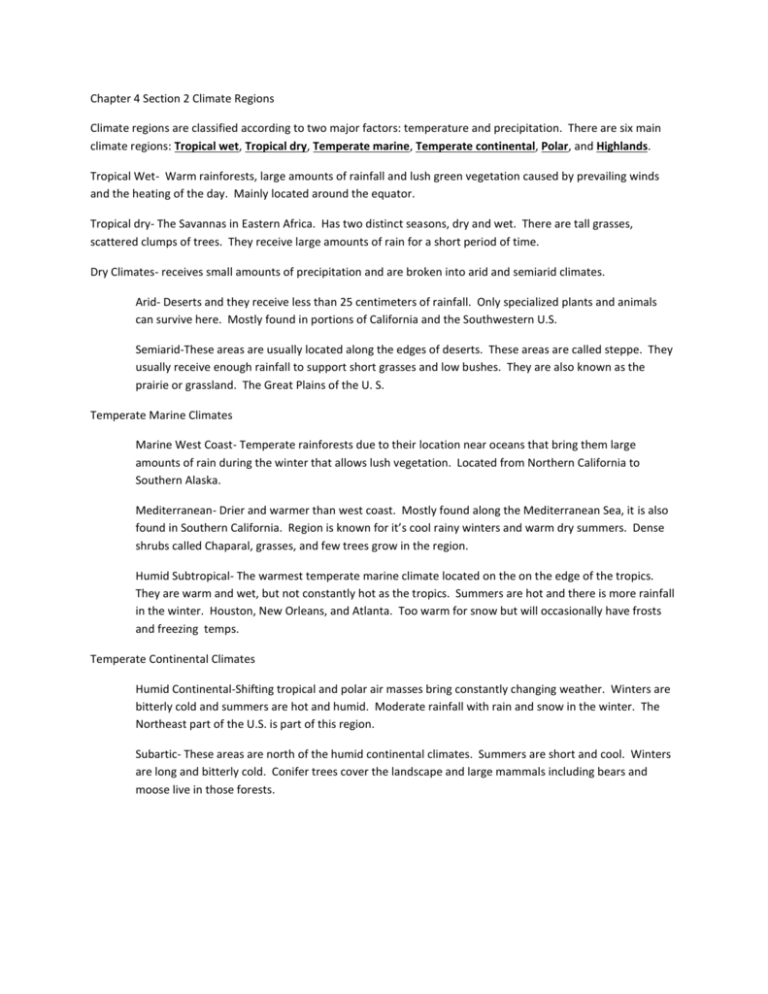
Chapter 4 Section 2 Climate Regions Climate regions are classified according to two major factors: temperature and precipitation. There are six main climate regions: Tropical wet, Tropical dry, Temperate marine, Temperate continental, Polar, and Highlands. Tropical Wet- Warm rainforests, large amounts of rainfall and lush green vegetation caused by prevailing winds and the heating of the day. Mainly located around the equator. Tropical dry- The Savannas in Eastern Africa. Has two distinct seasons, dry and wet. There are tall grasses, scattered clumps of trees. They receive large amounts of rain for a short period of time. Dry Climates- receives small amounts of precipitation and are broken into arid and semiarid climates. Arid- Deserts and they receive less than 25 centimeters of rainfall. Only specialized plants and animals can survive here. Mostly found in portions of California and the Southwestern U.S. Semiarid-These areas are usually located along the edges of deserts. These areas are called steppe. They usually receive enough rainfall to support short grasses and low bushes. They are also known as the prairie or grassland. The Great Plains of the U. S. Temperate Marine Climates Marine West Coast- Temperate rainforests due to their location near oceans that bring them large amounts of rain during the winter that allows lush vegetation. Located from Northern California to Southern Alaska. Mediterranean- Drier and warmer than west coast. Mostly found along the Mediterranean Sea, it is also found in Southern California. Region is known for it’s cool rainy winters and warm dry summers. Dense shrubs called Chaparal, grasses, and few trees grow in the region. Humid Subtropical- The warmest temperate marine climate located on the on the edge of the tropics. They are warm and wet, but not constantly hot as the tropics. Summers are hot and there is more rainfall in the winter. Houston, New Orleans, and Atlanta. Too warm for snow but will occasionally have frosts and freezing temps. Temperate Continental Climates Humid Continental-Shifting tropical and polar air masses bring constantly changing weather. Winters are bitterly cold and summers are hot and humid. Moderate rainfall with rain and snow in the winter. The Northeast part of the U.S. is part of this region. Subartic- These areas are north of the humid continental climates. Summers are short and cool. Winters are long and bitterly cold. Conifer trees cover the landscape and large mammals including bears and moose live in those forests. Polar Climates Ice Caps- Antarctica and Greenland where the temperatures are always at or below freezing. The land is covered with snow and ice. Air is very dry and lichen that grow on rocks are the only plants that can survive in this region. Tundra- region stretches across Northern Alaska , Canada, and Russia. Permafrost is permanently frozen soil. The ground thaws only a few inches in the summer creating a boggy type environment. Due to the short summers the growing season is short as well. Shallow rooted plants and shrubs can grow. Highlands- a very distinct region, usually mountainous and they are colder than the area around them. At the bottom of the mountain the vegetation is lush with large conifer trees. As you go up the mountain, the vegetation changes to shrubs and small plants. Chapter 4 Section 3 Notes/Study Guide Long-Term Changes in Climate Studying Climate Change If plants and animals need specific conditions to live today, then similar plants and animals needed those same conditions in the past. Plants have specific types of pollen. Pollen can be found in the mud in the bottoms of lakes. By studying pollen types, scientists can determine what plant life was found near that lake in the past. Different layers of mud may have differing pollen types Scientists can determine that the climate near a lake was similar in the past to the climate in which that type of pollen is found today. Tree rings can demonstrate precipitation levels. Thick rings show wet years, thin rings show dry years. Ice Ages Times in which glaciers coverd much of Earth’s surface (see Fig. 19, pg 132 for glacial coverage 18,000 years ago) Glaciers carve grooves in rock, deposit sediments at their borders, and move rock great distances. More glaciers = lower ocean levels, as the glaciers melted, coasts were flooded and the Great Lakes formed. Causes of Climate Change Earth’s orbit, axial tilt, and distance to the sun change slightly over great periods of time (~23,000 years), these subtle changes can combine to cause more pronounced climate changes, including ice ages The sun is not a constant: sunspots are dark, cooler areas on the surface of the sun. When more sunspots are present, the sun tends to produce more energy, possibly warming Earth Volcanoes send much ash and gas into the atmosphere, which can spread out to cover the entire planet, filtering some sunlight and causing a cooling trend As continents move, the oceans, seas, and land masses change. This causes changes in climate. Also, continents near the polar zones were once near the equator (tropical zone), and the climate on those continents has changed

